Anthropology Grants
FIELD AND RADIOMETRIC ASSESSMENT OF UNEXAMINED FOSSILIFEROUS CAVES
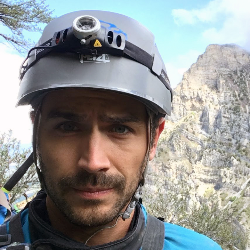 Associate Professor J. Tyler Faith (PI)
Associate Professor J. Tyler Faith (PI)
Justing Pargeter (Co-PI), Dominic Stratford (Co-PI)
![]() NSF Grant
NSF Grant
01-Apr-2025 ~ 31-Mar-2026
$34,952.00
ABSTRACT:
The fossil record informs evolutionary history, but current knowledge has been drawn
from finds located in a small number of sites from geographically restricted areas.
This situation partially accounts for existing gaps in the fossil record, limiting
knowledge regarding fundamental questions about our species. This study aims to expand
the evolutionary record by (i) surveying for new fossil-rich cave sites, (ii) conducting
exploratory excavations to evaluate the fossil record preserved within them, and (iii)
dating the cave sites to establish the age of the fossiliferous deposits. The project
enhances US research capacity by providing student training opportunities and strengthening
research links across a broad network of scholars.
This project examines the paleoanthropological and paleontological research potential
of fossiliferous caves through a combination of drone-assisted and pedestrian surveys.
At five caves known or suspected to preserve rich fossil deposits, paleontological
test excavations document the fossil record preserved within them. Samples generated
through excavations are used for radiometric dating, utilizing a combination of radiocarbon
and U-series approaches. This project expands paleontological and paleoanthropological
research.
COLLABORATIVE RESEARCH: INVESTIGATING THE IMPACT OF REARING PRACTICES ON THE SOCIAL INTEGRATION OF A NON-HUMAN PRIMATE SPECIES ACROSS THE LIFESPAN
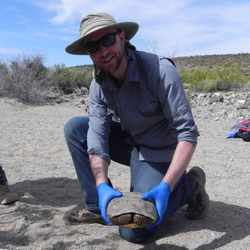 Assistant Professor Timothy Webster (PI)
Assistant Professor Timothy Webster (PI)
![]() NSF Grant
NSF Grant
15-Sep-2024~31-Aug-2028
$212,889.00
ABSTRACT:
Social integration (interconnection to others and location within the social network)
has been associated to health, survival, and reproductive success in several social
species, including humans and non-human primates. Despite its importance, the pathways
through which non-human primates develop social integration are poorly understood.
This study addresses this issue through the longitudinal study of a social non-human
primate species that has significant commonalities with humans (e.g., fission-fusion
dynamics and cooperative infant care). The study follows individuals from birth to
adulthood, analyzes allomaternal (non-mother) care, and assesses how social bonds
form, and how individuals become integrated into social networks. The longitudinal
nature of the study allows for the examination of social integration changes, as well
as its impacts, across the life span. The study develops educational materials for
the public and K-12 students. The study also trains students from diverse geographic
regions.
To investigate how early rearing environments and maternal social networks impact
the origins and development of social integration the study focuses on a non-human
primate species with high variability in rearing strategies. Given that individuals
from this species are born in litters the study compares sibling, that shared the
same rearing environment, as well as non-siblings. The selected species has a short
developmental period that allows for the longitudinal study of social integration
across the lifespan. Researchers collect data on rearing strategies (single vs. communal
nesting, allomaternal care presence/absence as well as quantity), social integration
(through social network analysis), and rearing choices. Ultimately, the study evaluates
the impact of allomaternal care and cooperative breeding on the evolution of social
integration.
RECONSTRUCTING PLEISTOCENE-HOLOCENE LIFEWAYS IN NORTH AMERICA
 Assistant Professor Alexandra Greenwald (PI)
Assistant Professor Alexandra Greenwald (PI)
![]() NSF Grant
NSF Grant
15-Aug-2024~31-Jul-2027
$269,998.00
ABSTRACT:
This project examines the Pleistocene-Holocene Transition (PHT), during which the
first peoples of North America were dispersing across the continent and adapting not
only to novel environments, but also to a rapidly changing climate as the Ice Age
ended. Anthropologists? understanding of this time period is limited by a paucity
of archaeological sites. The principal investigator, in collaboration with Tribal
descendant partners, studies a mortuary site using a range of biological and biogeochemical
methods to advance knowledge about PHT residents of North America, including colonization
of the Americas, the lifeways of the earliest Indigenous occupants, and human adaptation
to rapid climatic shifts. The project supports undergraduate and graduate student
training, research collaborations and community engagement with the Muwekema Ohlone
Indian Tribe, and public science education activities.
The project focuses on an archaeological site that dates to 12,000-9,000 years ago
and was used by the ancestors of the Muwekma Ohlone Indian Tribe of the San Francisco
Bay Area as a burial ground for their relatives. This is among the oldest known mortuary
sites in North America and contains a large number of Indigenous ancestors (n=41).
The project is a collaborative effort with the Muwekma Ohlone Indian Tribe to improve
collective understanding of their ancestors? lifeways and the adaptive strategies
employed by North America?s first peoples. Specifically, the project seeks to reconstruct
mobility, kinship systems, diet, parental investment strategies, and associated fertility
by employing proteomic sex-estimation, stable isotope analysis (carbon and nitrogen)
of dentinal serial sections of first and third molars, and strontium analysis of tooth
enamel. The research outcomes include the generation of osteobiographies that allow
ancestors? life stories and Tribal history to be told.
COLLABORATIVE RESEARCH: BUILDING THE GROUP IDENTITY CONCEPT FROM THE GROUP UP
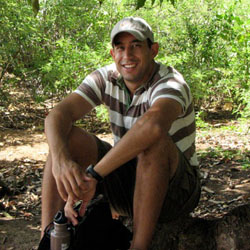 Associate Professor Adrian Bell (PI)
Associate Professor Adrian Bell (PI)
![]() NSF Grant
NSF Grant
01-Sep-2023~31-Aug-2026
$159,098.00
ABSTRACT:
Individuals in our increasingly connected society straddle multiple social worlds.
Understanding the intersecting identities that result from these connections is a
pressing challenge for social science and policy. This project uses both cross-cultural
empirical research and theory-driven mathematical modeling to conceptualize and measure
group affiliations, developing a suite of empirical and conceptual tools for social
scientists to better engage with the complexities of modern social life. The project
trains a post-doctoral scholar and PhD student in scientific and mathematical methods
and theory. It also creates interactive, publicly available online tools that (1)
explain theories of group membership, (2) illustrate how we can empirically measure
group affiliations and the relationships between groups, and (3) demonstrate how the
integration of theory and measurement can create a more accurate picture of how our
social worlds evolve.
This work builds on theories that assert that outward expressions of identity are
used instrumentally to facilitate assortment and expedite social interactions, including
cooperation and aggression. While these theories are well supported, they often present
a limited, unidimensional characterization of identity. In this project, investigators
develop cultural evolutionary theory to understand how multifaceted group affiliations
respond to individual incentives, including the costs and benefits of coordinating
identities and cooperation. Specifically, it builds a new statistical approach that
identifies and measures the relationships between real groups. Models are iteratively
refined via tests using ethnographic data collected to capture how people understand
their own and others? identities across multiple realms of interaction. Despite being
evident that individuals hold multiple group affiliations, we do not currently have
analytical tools or language that adequately describes the complex nature of group
affiliations. This project builds these tools to contribute to understanding how individuals
position themselves across a range of social relationships.
RISES: RESTORING INDIGENOUS SOCIO-ENVIRONMENTAL SYSTEMS (RISES)
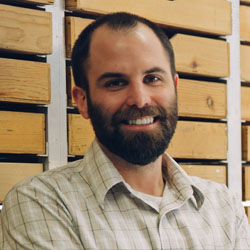 Professor Brian Codding (PI)
Professor Brian Codding (PI)
Andrea Brunelle (Co-Principal Investigator), Danielle Endres (Co-Principal Investigator), Simon Brewer (Co-Principal Investigator) , Eric Lamalfa (Co-Principal Investigator)
![]() NSF Grant
NSF Grant
15-Aug-2023 ~ 31-Jul-2026
$1,599,707.00
ABSTRACT:
Indigenous practices influenced plant and animal distributions across the planet for thousands of years. Research shows that biodiversity and ecosystem health are often higher where Indigenous socio-environmental systems (SES) persist. Yet in many locations around the world, including North America, these dynamics were interrupted by colonial invasions. Centuries of intensive agriculture and industrial activities have altered ecosystems and eroded traditional relationships between Indigenous people and ecosystems. In this project a multidisciplinary team develops a framework for Restoring Indigenous Socio-Environmental Systems (RISES). This framework is applied to a restoration effort on Tribal land. The restoration is led by the Northwestern Band of the Shoshone Nation in the Bear River Basin. The team is quantifying long-term Indigenous SES dynamics. They are modeling the drivers of SES change that are critical for conservation goals. That information is being disseminated to land managers and the public. In addition, the project trains many tribal youth, undergraduate, and graduate students.Uncovering past Indigenous SES dynamics is being accomplished through a convergence of enduring traditional knowledge, community ecology, historical ecology, archaeology, and paleoecology. Restoration of the dynamics takes place with the collaboration and shared leadership of Indigenous communities. These communities are typically left out of restoration projects to the detriment of both social and environmental systems. This project develops a generalizable convergence framework. That framework quantifies long-term socio-environmental dynamics, evaluates the drivers of change in the system, and synthesizes findings. It does so using statistical and process-based models that include estimates of uncertainty to evaluate the potential efficacy of alternative restoration scenarios under future climate regimes. Finally, it leverages the findings to engage community members, Indigenous secondary and university students, and land managers, all within a collaborative framework of shared knowledge generation and problem solving. Drawing on long-standing and emerging hypotheses across the natural and behavioral sciences, the project evaluates the drivers of SES dynamics. These include the role of gradual vs. stochastic processes on SES stability, resilience, and tipping points. They are being integrated in a framework capable of forecasting with estimates of uncertainty under future climate scenarios.
AN EXAMINATION OF SETTLEMENT AND SUBSISTENCE PATTERNS IN THE MT. IRISH RANGE USING STARCH GRANULE ANALYSIS AND BOTANICAL SURVEYS
 Associate Professor Lisbeth Louderback (Co-PI)
Associate Professor Lisbeth Louderback (Co-PI)
Dayna Tinsley (PI)
Lincoln County Archaeological Initiative
01-May-2023 ~ 01-Apr-2026
$150,000.00
ABSTRACT:
G2 Archaeology (G2) and the Natural History Museum of Utah (NHMU) will conduct starch granule analysis on bedrock milling features and ground stone artifacts at 12 sites located on land administered by the Bureau of Land Management (BLM) in the Mt. Irish Range. The proposed research titled An Examination of Settlement and Subsistence Patterns in the Mt. Irish Range using Starch Granule Analysis and Botanical Surveys builds off our previous study conducted for LCAI Round 11, Testing the Pinyon Premise: Archaeobotanical Analyses of Sediments, Bedrock Milling Features, and Ground Stone Artifacts from West-Central Lincoln County, Nevada (BLM Report 8111 CRR NV 040-FY2255). For the current study, they will focus on collecting field data (i.e., starch residue, vegetation descriptions, plant specimens, and grinding surface morphology) and reanalyzing data collected from previous studies to address questions related to prehistoric settlement and subsistence in the Mt. Irish Range. The goal is to draw from existing obsidian sourcing and hydration data (Giambastiani et al. 2015), previous rock art studies (Giambastiani et al. 2015; Quinlan 2010a, 2010b), recently collected starch residue and botanical data (Tinsley et al. 2021), ethnographic data (Giambastiani 2020), and other archival sources to gain a comprehensive understanding of prehistoric land-use in the Mt. Irish Range. Unlike the previous study for Round 11 (Tinsley et al. 2021), this effort will also include botanical studies in adjacent mountain ranges (e.g., Timpahute, Golden Gate, Seaman, and East Pahranagat) to further our understanding of available ethnographic plant species.
COLLABORATIVE RESEARCH: INTEGRATING MODERN AND PALEO PERSPECTIVE TO DISENTANGLE GRAZER AND CLIMATE CONTROLS ON FIRE ACTIVITY
 Associate Professor J. Tyler Faith (PI)
Associate Professor J. Tyler Faith (PI)
![]() NSF Grant
NSF Grant
01-Jan-2023 ~ 31-Dec-2025
$74,683.00
ABSTRACT:
Fire is an Earth system process with both vegetation and atmospheric feedbacks. Grass-fueled
fires in savannas currently dominate global burned area, but grazers potentially eat
enough grass to suppress fires at the landscape scale. How these processes affect
global biogeochemical cycles is not quantitatively understood. This project combines
present-day experiments and observations with paleoecological observations on the
timescale of thousands of years. The project tests predictions about the dynamics
of fire activity in response to climate and herbivory. The overall hypothesis is that
grazer controls on fire activity are substantial but depend on environmental context.
Exhibits at the Yale Peabody Museum of Natural History and the Natural History Museum
of Utah are being developed to teach about fire in the Earth system. Particularly,
museumgoers are learning about the role and dynamics of fire in the Earth system through
time. Early career scientists, such as undergraduate students, graduate students,
and postdoctoral associates are being mentored through this project, contributing
to the STEM workforce.
The project uses a combination of present-day and paleoecological datasets across
Africa: (i) nine present-day herbivore exclusion experiments, (ii) spatially extensive,
present-day observational records from a combination of remote sensing and on-the-ground
monitoring, and (iii) five paleoecological archives in eastern Africa, spanning the
last 20,000 years. Paleoecological records are being compiled from Lakes Chala and
Tanganyika. Existing records at Lukenya Hill, Kenya and Lakes Victoria and Turkana
are being strengthened with new proxy reconstructions of fire history and herbivory.
The proposed work advances our understanding of a neglected fire driver in the Earth
system and generates new paleorecords that are useful to researchers from numerous
disciplines, including archaeology, paleontology, paleoecology, and paleoclimatology.
COLLABORATIVE RESEARCH: DEVELOPING A HIGH-RESOLUTION FRAMEWORK TO DEFINE HUMAN-ENVIRONMENT INTERACTIONS
 Associate Professor J. Tyler Faith (PI)
Associate Professor J. Tyler Faith (PI)
![]() NSF Grant
NSF Grant
01-Jun-2022 ~ 31-May-2026
$51,926.00
ABSTRACT:
This interdisciplinary project will examine the role of climate-driven environmental
change in shaping the behavioral evolution of early modern humans. Scientists have
long proposed that environmental pressures influenced complex behaviors that parallel
those of recent hunter-gatherers. Yet, it has been challenging to identify cause-effect
relationships in the archaeological record. These challenges stem from the rarity
of precisely dated sites that preserve the archaeological and paleoenvironmental data
needed to disentangle natural and human system interactions. This project will resolve
this issue by assembling a diversity of high-resolution climatic, environmental, and
archaeological datasets to understand the nature of the transition from Middle to
Later Stone Age technologies. In addition to addressing fundamental questions about
the emergence of behavioral complexity in Homo sapiens, this work builds U.S. scientific
research capacity by fostering research links across networks of scholars, and providing
a foundation for undergraduate and graduate student training.
The transition from Middle to Later Stone Age technologies is one of the most prominent
behavioral shifts observed in Homo sapiens? evolutionary history. Understanding what
precipitated this transition is closely intertwined with discussion and debates about
the origins of modern human behavior. This project tests the hypothesis that the technological,
dietary, and social shifts associated with the Middle to Later Stone Age transition
result from climate-driven environmental change, specifically changes in the seasonal
distribution of foods and other resources. This work will be accomplished through
a combination of (i) archaeological excavations that will document behavioral change
across the Middle to Later Stone Age transition, coupled with (ii) the assembly of
both local- and regional-scale paleoenvironmental records that will inform on past
climate dynamics and its effects on terrestrial ecosystems. The datasets generated
in this study will contribute to unresolved questions about modern human origins.
They will also enable future research across numerous disciplines, including archaeology,
paleontology, paleoecology, and paleoclimatology.
GENETIC EVIDENCE ON THE DEEP HISTORY OF HUMAN POPULATIONS
 Professor Alan Rogers (PI)
Professor Alan Rogers (PI)
Timothy Webster (Co-PI)
![]() NSF Grant
NSF Grant
01-Jun-2020 ~ 31-Aug-2025
$267,670.00
ABSTRACT:
Recent research has shown that modern humans carry DNA derived from archaic hominin populations, such as Neanderthals and Denisovans, in the distant past. This project will use genetic data, together with a newly-developed statistical method, to study the history of humans and their close relatives during the past two million years. The results will inform us about the speed with which populations become reproductively isolated after separation. The methods will be of interest to conservation biologists, who must estimate rates of interbreeding in order to decide whether a species deserves protected status. The results also will be useful to medical researchers who must control for the effects of history as they study the causes of genetic disease. The project will support graduate training, as well as a workshop that will train geneticists from throughout the US in methods of bioinformatics and computational genetics and support efforts to broaden participation in STEM research.
Modern humans carry genetic signatures of past admixture with Neanderthals and Denisovans. Research has also documented episodes of very small population size, during which natural selection was ineffective, and harmful mutations were able to accumulate. Our understanding of these events is incomplete however, because of limitations in the statistical methods used. The current project will use a new method, which corrects these problems and allows us to see farther into the past. It will (1) estimate the fraction of Denisovan DNA in several human populations of Asia and Oceania; (2) study interbreeding between modern humans and ?superarchaics,? who separated from other hominins early in the history of the genus Homo; and (3) test the hypothesis that Middle Eastern populations received gene flow from a hypothetical population of ?basal Eurasians,? which separated from other Eurasians before the separation of Europeans from East Asians.
COLLABORATIVE RESEARCH: TAPHONOMIC CORRELATION FOR PAST EVENTS
 Professor Brian Codding (PI)
Professor Brian Codding (PI)
![]() NSF Grant
NSF Grant
1-Sep-2019 ~ 31-Aug-2025
$94,672.00
ABSTRACT:
This project will develop new methods estimating past population sizes, in order to more accurately reconstruct past population dynamics. Accurately reconstructing past population dynamics is critical for addressing many key questions about the human past, including the origins of modern behavior, the emergence of agriculture, and the development of states. Although estimates of past population size are widely employed, current archaeological methods struggle to adequately account for the fact that the available records of past human habitation are biased by local geologic processes, which preserve sites of some ages while destroying others. This can lead to systematic bias in estimates of past population, erroneous reconstructions of past population dynamics, and mistaken interpretations of social processes. This project develops a novel approach that analyzes ages of archaeological sites relative to local frequencies of landforms of varying ages, using the Bonneville Basin (Utah and Nevada) as a test case. By providing a method that is capable of more accurately describing past populations, this project will enable improved analysis of past human responses to environmental changes as well as the potential impacts of human populations on past environments.
Archaeologists increasingly turn to assemblages of radiocarbon dates as measures of past population sizes. Improving the accuracy of this technique by accounting for landscape change over time will allow us to explore the drivers of past population dynamics in the Bonneville Basin, especially the interactions between human demography, subsistence adaptations, land use, and environmental change. By developing a new methodology for addressing biases in assemblages of radiocarbon dates, illustrating the potential of the method through this Great Basin case study, and disseminating the tools that other researchers can use to replicate the approach, this project will open new possibilities in reconstructing past population dynamics. In addition, by standardizing an approach and providing computational tools for coupling the archaeological radiocarbon record and local landscape history recorded in landform ages, this work will enable further research that addresses compelling questions including the role of population dynamics in long-term sustainability and resilience, in the onset of the Anthropocene, and in such social transformations as the beginnings of agriculture and urbanism
COLLABORATIVE RESEARCH: THE ECOLOGICAL BASIS OF HUNTING AND MEAT SHARING IN FEMALE SAVANNA CHIMPANZEES
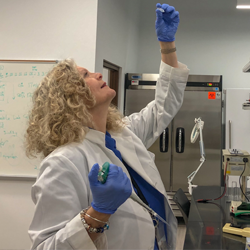 Professor Leslie Knapp (PI)
Professor Leslie Knapp (PI)
S. Lindshield (Collaborator), J. Pruetz (Collaborator), E. Flahrety (Collaborator), F. Zhu (Collaborator)
![]() NSF Grant
NSF Grant
15-Aug-2020 ~ 31-Jul-2025
$152,220.00
ABSTRACT:
Hunting with tools may enable female chimpanzees to routinely ingest and share meat on a seasonal basis without the need for being provisioned by males. This project will capture the dietary impacts of female chimpanzee hunting with tools and compare these findings with other studies that have focused primarily on male chimpanzee hunting behaviors. The findings from this project will advance knowledge and broaden perspectives about primate models for understanding human behavioral evolution. This project increases capacity for chimpanzee research by fully engaging with and supporting local partners and students. The research is part of a long-term program that supports habitat preservation in protected and unprotected areas for the critically-endangered western chimpanzee. The research further engages in conservation activities through the active study of conservation genetics, development of conservation action plans, and support of local research and community services in the research area. The project provides exceptional research opportunities for undergraduate and graduate students, especially underrepresented minority and first-generation students to support diversity and inclusion efforts in biological anthropology and STEM, more broadly. This project also interfaces with Purdue University?s EPICS program (Engineering Projects in Community Service) to provide collaborative design experiences for undergraduate students.
Sexual selection theory and patterns of male-biased hunting and meat eating for chimpanzees (Pan troglodytes) have been traditionally integrated with models of human behavioral evolution. While there is a well-documented understanding of these behaviors in forest chimpanzees, a significant gap exists on how chimpanzees hunt and eat meat in savannas. What little is known about hunting and meat-eating in savanna chimpanzees, however, starkly contrasts with the typical species pattern. In the hottest, driest, and most open landscapes inhabited by chimpanzees, tool use and female-biased hunting comprise a major component of hunting strategy. This study will test for environmental pressures that may explain this behavior. Little is known about female-biased hunting because these timid chimpanzees are not habituated for intensive behavior sampling, and are not being habituated due to their conservation status combined with risk of infant poaching for the pet trade. To confront this challenge, the project combines behavioral, isotopic, nutritional, genetic, visual analytic, and geographic approaches to compare hunting and meat ingestion between females and males, and in relation to climate and food availability. This interdisciplinary and multi-site study is a part of the HUNTRESS project on HUnting, Nutrition, Tool-use, Reproductive Ecology, and meat Sharing in Savanna chimpanzees to holistically assess female-biased hunting. The project will measure meat ingestion with stable isotope and feeding trace analyses, and compare these signatures to direct observations of hunting and meat ingestion in a reference group of habituated adult males. Furthermore, the project will compare meat ingestion to annual climate trends as well as food and macronutrient availability. A molecular component will enable sex-determination and individualization information from hair and feces. The video analytics component will measure mammal (prey) availability remotely from camera-trap videos and still images. At the same, the research will advance machine-learning capabilities by incorporating domain knowledge to improve accuracy and precision of mammal localization.
SHIFTING MARKET AND CLIMATE INFLUENCES ON SHOCIAL NETWORKS, LABOR ALLOCATIONS AND WELLBEING AMONG RURAL FARMERS
 Professor Karen Kramer (PI)
Professor Karen Kramer (PI)
Joseph Hackman (Co-PI)
![]() NSF Grant
NSF Grant
01-May-2021 ~ 30-Apr-2025
$289,358.00
ABSTRACT:
Globalization and increasing environmental variability have transformative effects on people living in small agricultural communities worldwide. Because these forces present both opportunities and challenges, the path forward in how to make a living is often uncertain. Is it better to give up farming, move to an urban area, become a wage-laborer, leave family behind, and sever ties with one?s birth community? How do these decisions affect the wellbeing of families? This project examines how small-scale farmers navigate these decisions. Specifically, the researchers collect new data to assess whether the reliance on family versus formal institutions for social support is influenced by household economic decisions, and what impact this has on the wellbeing of rural families when faced with the dual challenge of increasing environmental variability and globalization. The project provides scientific and STEM-field research experience to undergraduate and graduate students and professional training to postdoctoral researchers, as well as valuable information for non-governmental organizations and policy makers.
This research provides a novel test of economic, sociological, and cultural anthropological theories to address the extent to which opportunities associated with market transition trade off as they interact with environmental variability to affect farmers? livelihoods. Using a longitudinal design, ethnographic, and cutting-edge social network methods, the researchers aim to characterize (1) how social relationships and economic activities are affected by market transition over time; and (2) how reliance on relationships versus labor market participation are associated with health and well-being. The researchers investigate further the extent to which climate variables affect people's social relationships, economic activities, and daily lives, creating much-needed links between social and climate science. Finally, the research provides validity tests and other tools to meet the stated needs of Vulnerability Assessments required by policy makers and non-governmental organizations (NGOs) involved in economic development. Together, findings from the research will provide pertinent insight into the scale at which climate and market variables together affect human behavior and how farmers manage changes in their social, economic, and ecological environments.
EARLY LIFE EFFECTS ON HEALTH DURING RAPID LIFESTYLE CHANGE: EVOLUTIONARY AND MOLECULAR MECHANISMS
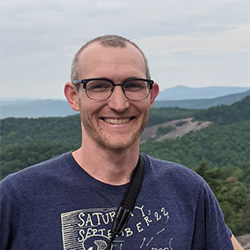 Assistant Professor Thomas Kraft (Co-PI)
Assistant Professor Thomas Kraft (Co-PI)
Ian Wallace (PI)
![]() NSF Grant
NSF Grant
15-Apr-2022 ~ 31-Mar-2025
$90,872.00
ABSTRACT:
The environments that people are born and raised in can have profound and long-lasting effects on their biology, but precisely how and why early life environmental factors ?get under the skin? to influence physiology and health in later life remains poorly understood. This project explores the mechanistic and evolutionary bases of early life effects on later life biological outcomes in groups living in environments that are dramatically different from those they encountered early in life. Insights from such groups, who are undergoing rapid lifestyle changes due to increasing market integration, acculturation, and urbanization, advance knowledge about biological connections across the lifespan, in the context of biocultural theory. The project may also inform global health research, given that many human groups are undergoing similar lifestyle changes, as well as inform our understanding of the complex causes of some of the greatest health threats faced by people in the United States and other high-income countries. The research provides many scientific training opportunities for undergraduate, graduate, and postdoctoral students, as well as participating community members. Through partnerships with mobile clinics, this research is also directly contributing to improving health care among participating groups.
In order to uncover the mechanistic and evolutionary bases of early life effects on later life biological outcomes, this research has three general goals. First, the researchers use detailed interviews and direct measurements of numerous behavioral, anthropometric, and physiological traits to characterize the early life and current environments of study participants and their current physiological status. Second, using these data and previously established modeling methods, the researchers test competing explanations for how early life effects on later life health evolve, including the well-known but insufficiently tested ?developmental constraints'' and ?predictive adaptive responses? hypotheses. Third, the researchers are using cutting-edge genomic techniques to identify the genes and gene regulatory processes that mediate early life environmental influences on later life health by measuring genome-wide DNA methylation and gene expression levels and linking these genomic mechanisms to both the environmental stimuli to which they are responsive and their downstream health consequences. An especially innovative and promising feature of this research is that it integrates theory and methods from a variety of scientific fields including human evolutionary biology, behavioral ecology, epidemiology, biomedicine, and genomics.
